Project Appraisal Techniques Report: Financial Management Analysis
VerifiedAdded on 2023/06/11
|10
|2296
|95
Report
AI Summary
This report provides a comprehensive analysis of project appraisal techniques, crucial for effective financial management. It begins with an executive summary and delves into key aspects of project management, including project selection, cost management, funding, and project implementation. The report emphasizes the importance of assessing project feasibility, managing costs through techniques like variance analysis and CVP analysis, and securing appropriate funding. Part A of the report offers a generic overview of project management principles, while Part B applies these concepts to a case study involving Mayer Holdings Limited, including calculations of Net Present Value (NPV) and the impact of exchange rate fluctuations on project profitability. The report concludes with a discussion of the financial implications of the project, its profitability, and the influence of external factors such as currency exchange rates. It references capital budgeting methods to evaluate project risk and return.
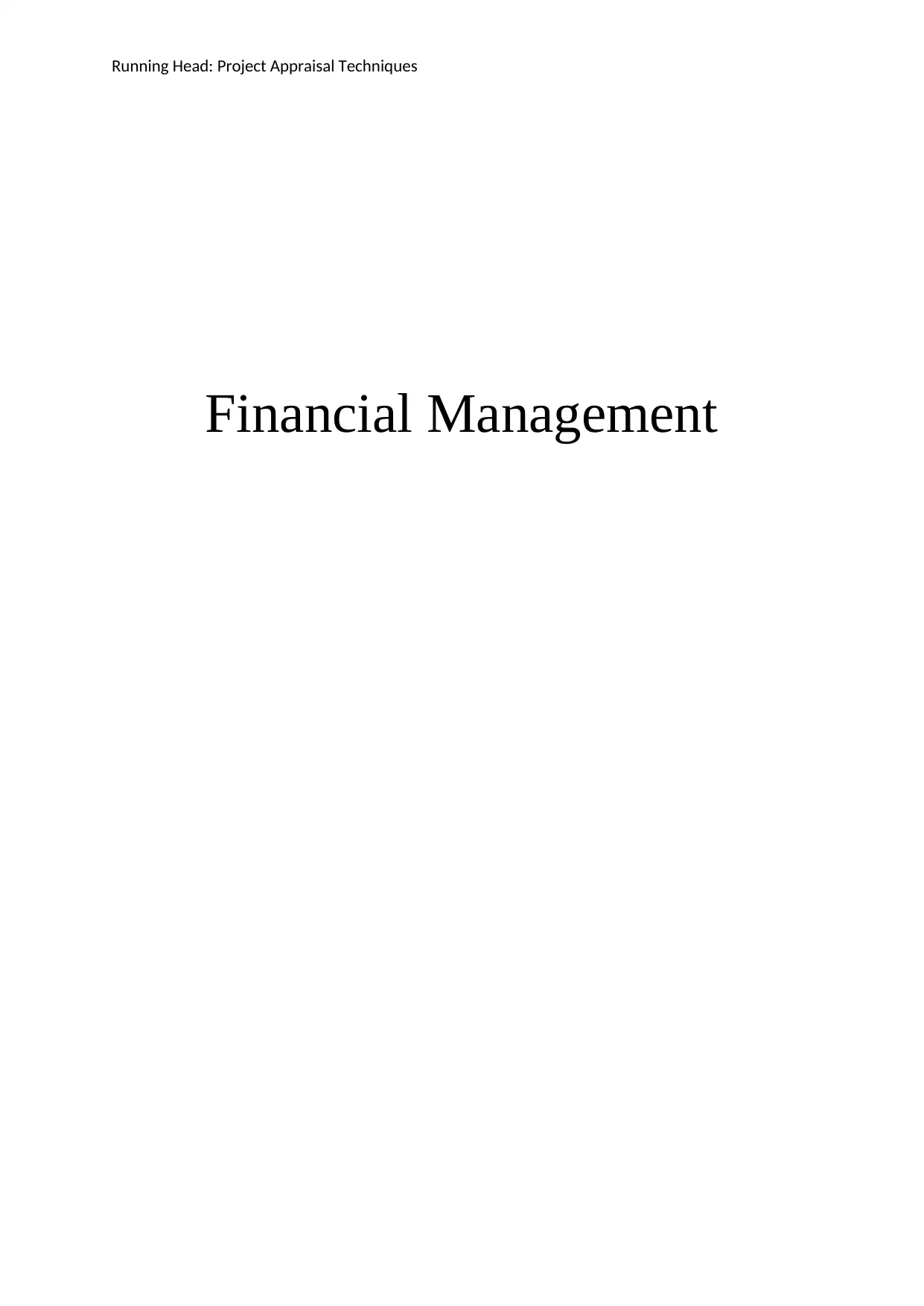
Running Head: Project Appraisal Techniques
Financial Management
Financial Management
Paraphrase This Document
Need a fresh take? Get an instant paraphrase of this document with our AI Paraphraser
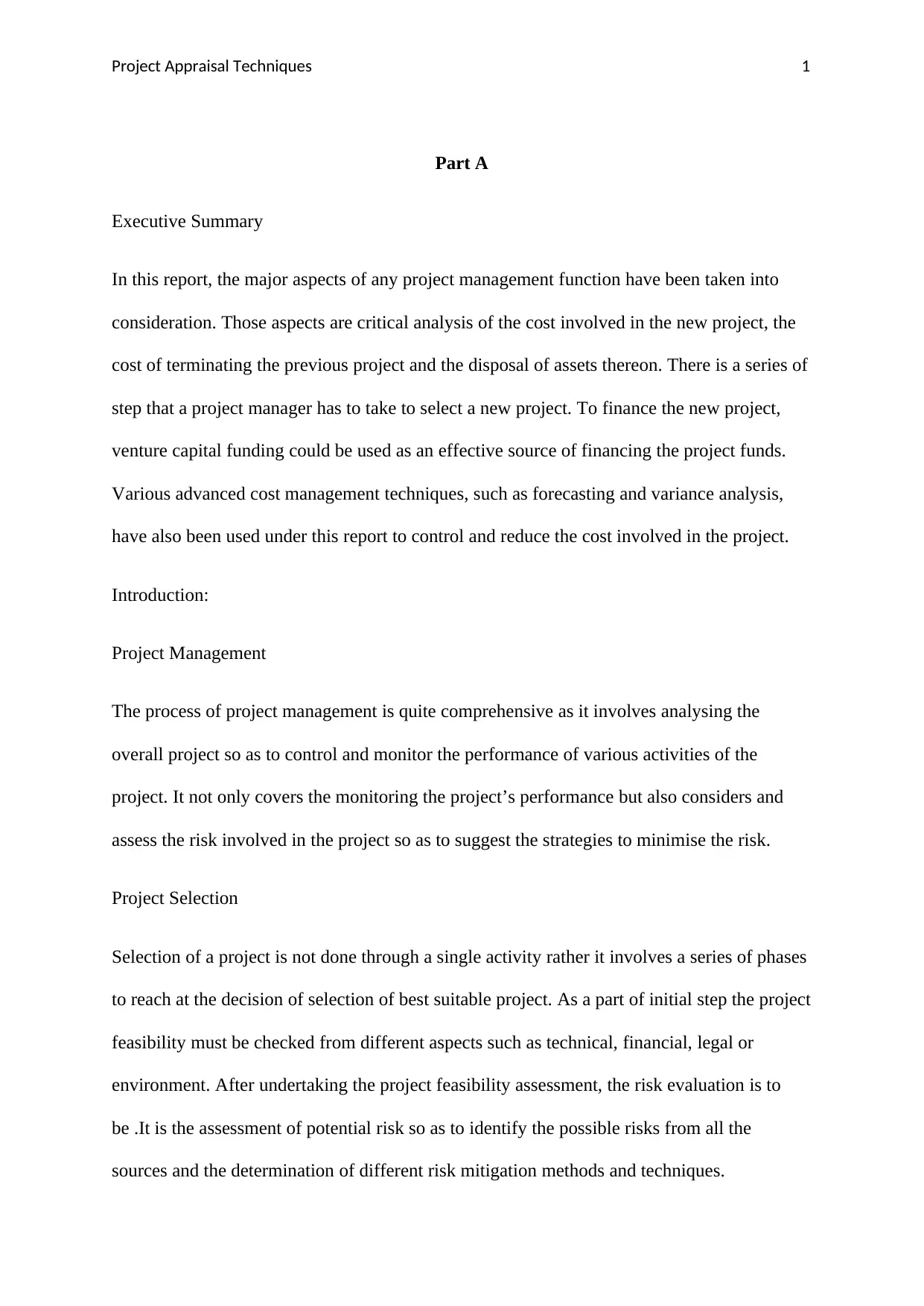
Project Appraisal Techniques 1
Part A
Executive Summary
In this report, the major aspects of any project management function have been taken into
consideration. Those aspects are critical analysis of the cost involved in the new project, the
cost of terminating the previous project and the disposal of assets thereon. There is a series of
step that a project manager has to take to select a new project. To finance the new project,
venture capital funding could be used as an effective source of financing the project funds.
Various advanced cost management techniques, such as forecasting and variance analysis,
have also been used under this report to control and reduce the cost involved in the project.
Introduction:
Project Management
The process of project management is quite comprehensive as it involves analysing the
overall project so as to control and monitor the performance of various activities of the
project. It not only covers the monitoring the project’s performance but also considers and
assess the risk involved in the project so as to suggest the strategies to minimise the risk.
Project Selection
Selection of a project is not done through a single activity rather it involves a series of phases
to reach at the decision of selection of best suitable project. As a part of initial step the project
feasibility must be checked from different aspects such as technical, financial, legal or
environment. After undertaking the project feasibility assessment, the risk evaluation is to
be .It is the assessment of potential risk so as to identify the possible risks from all the
sources and the determination of different risk mitigation methods and techniques.
Part A
Executive Summary
In this report, the major aspects of any project management function have been taken into
consideration. Those aspects are critical analysis of the cost involved in the new project, the
cost of terminating the previous project and the disposal of assets thereon. There is a series of
step that a project manager has to take to select a new project. To finance the new project,
venture capital funding could be used as an effective source of financing the project funds.
Various advanced cost management techniques, such as forecasting and variance analysis,
have also been used under this report to control and reduce the cost involved in the project.
Introduction:
Project Management
The process of project management is quite comprehensive as it involves analysing the
overall project so as to control and monitor the performance of various activities of the
project. It not only covers the monitoring the project’s performance but also considers and
assess the risk involved in the project so as to suggest the strategies to minimise the risk.
Project Selection
Selection of a project is not done through a single activity rather it involves a series of phases
to reach at the decision of selection of best suitable project. As a part of initial step the project
feasibility must be checked from different aspects such as technical, financial, legal or
environment. After undertaking the project feasibility assessment, the risk evaluation is to
be .It is the assessment of potential risk so as to identify the possible risks from all the
sources and the determination of different risk mitigation methods and techniques.
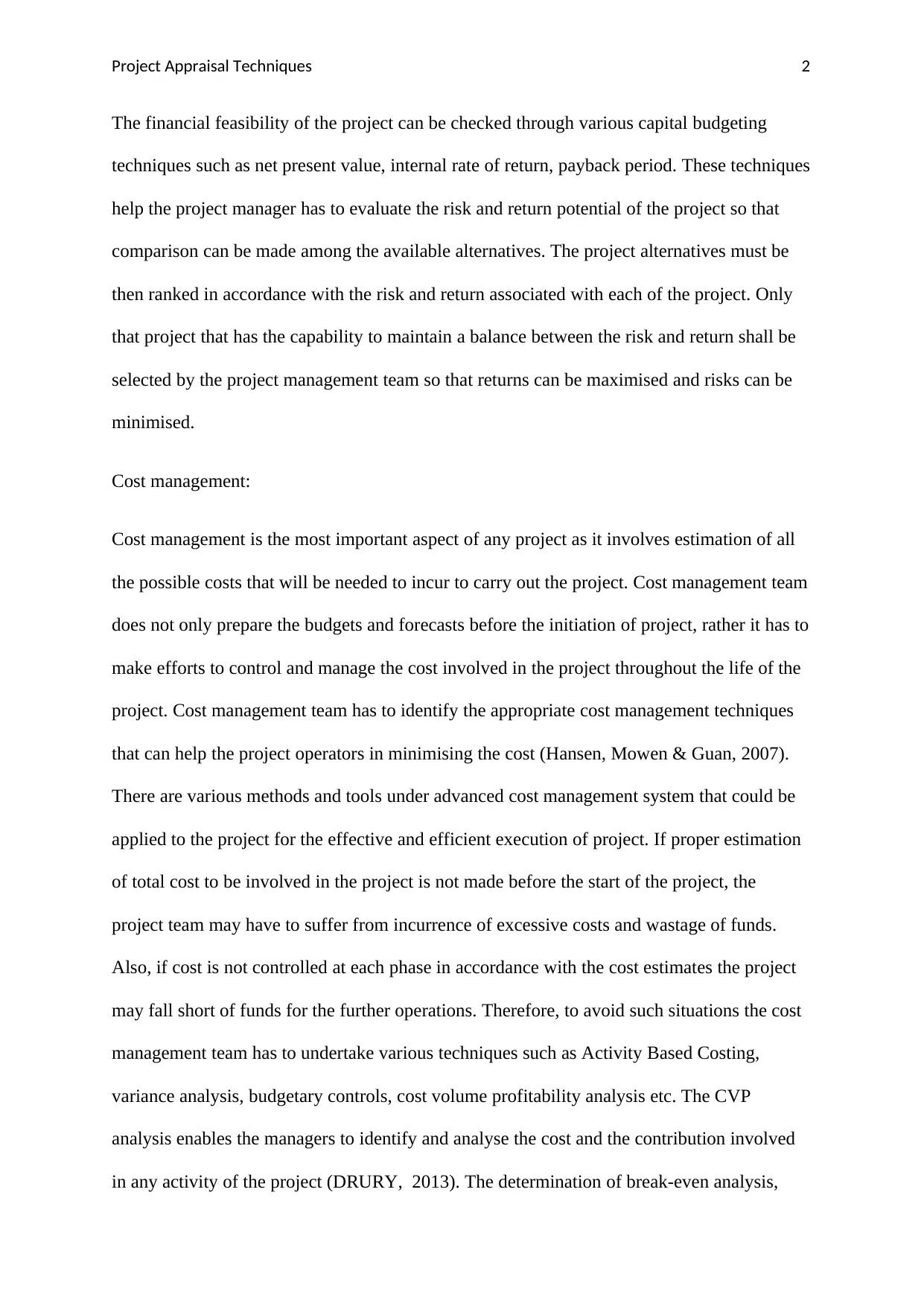
Project Appraisal Techniques 2
The financial feasibility of the project can be checked through various capital budgeting
techniques such as net present value, internal rate of return, payback period. These techniques
help the project manager has to evaluate the risk and return potential of the project so that
comparison can be made among the available alternatives. The project alternatives must be
then ranked in accordance with the risk and return associated with each of the project. Only
that project that has the capability to maintain a balance between the risk and return shall be
selected by the project management team so that returns can be maximised and risks can be
minimised.
Cost management:
Cost management is the most important aspect of any project as it involves estimation of all
the possible costs that will be needed to incur to carry out the project. Cost management team
does not only prepare the budgets and forecasts before the initiation of project, rather it has to
make efforts to control and manage the cost involved in the project throughout the life of the
project. Cost management team has to identify the appropriate cost management techniques
that can help the project operators in minimising the cost (Hansen, Mowen & Guan, 2007).
There are various methods and tools under advanced cost management system that could be
applied to the project for the effective and efficient execution of project. If proper estimation
of total cost to be involved in the project is not made before the start of the project, the
project team may have to suffer from incurrence of excessive costs and wastage of funds.
Also, if cost is not controlled at each phase in accordance with the cost estimates the project
may fall short of funds for the further operations. Therefore, to avoid such situations the cost
management team has to undertake various techniques such as Activity Based Costing,
variance analysis, budgetary controls, cost volume profitability analysis etc. The CVP
analysis enables the managers to identify and analyse the cost and the contribution involved
in any activity of the project (DRURY, 2013). The determination of break-even analysis,
The financial feasibility of the project can be checked through various capital budgeting
techniques such as net present value, internal rate of return, payback period. These techniques
help the project manager has to evaluate the risk and return potential of the project so that
comparison can be made among the available alternatives. The project alternatives must be
then ranked in accordance with the risk and return associated with each of the project. Only
that project that has the capability to maintain a balance between the risk and return shall be
selected by the project management team so that returns can be maximised and risks can be
minimised.
Cost management:
Cost management is the most important aspect of any project as it involves estimation of all
the possible costs that will be needed to incur to carry out the project. Cost management team
does not only prepare the budgets and forecasts before the initiation of project, rather it has to
make efforts to control and manage the cost involved in the project throughout the life of the
project. Cost management team has to identify the appropriate cost management techniques
that can help the project operators in minimising the cost (Hansen, Mowen & Guan, 2007).
There are various methods and tools under advanced cost management system that could be
applied to the project for the effective and efficient execution of project. If proper estimation
of total cost to be involved in the project is not made before the start of the project, the
project team may have to suffer from incurrence of excessive costs and wastage of funds.
Also, if cost is not controlled at each phase in accordance with the cost estimates the project
may fall short of funds for the further operations. Therefore, to avoid such situations the cost
management team has to undertake various techniques such as Activity Based Costing,
variance analysis, budgetary controls, cost volume profitability analysis etc. The CVP
analysis enables the managers to identify and analyse the cost and the contribution involved
in any activity of the project (DRURY, 2013). The determination of break-even analysis,
⊘ This is a preview!⊘
Do you want full access?
Subscribe today to unlock all pages.

Trusted by 1+ million students worldwide
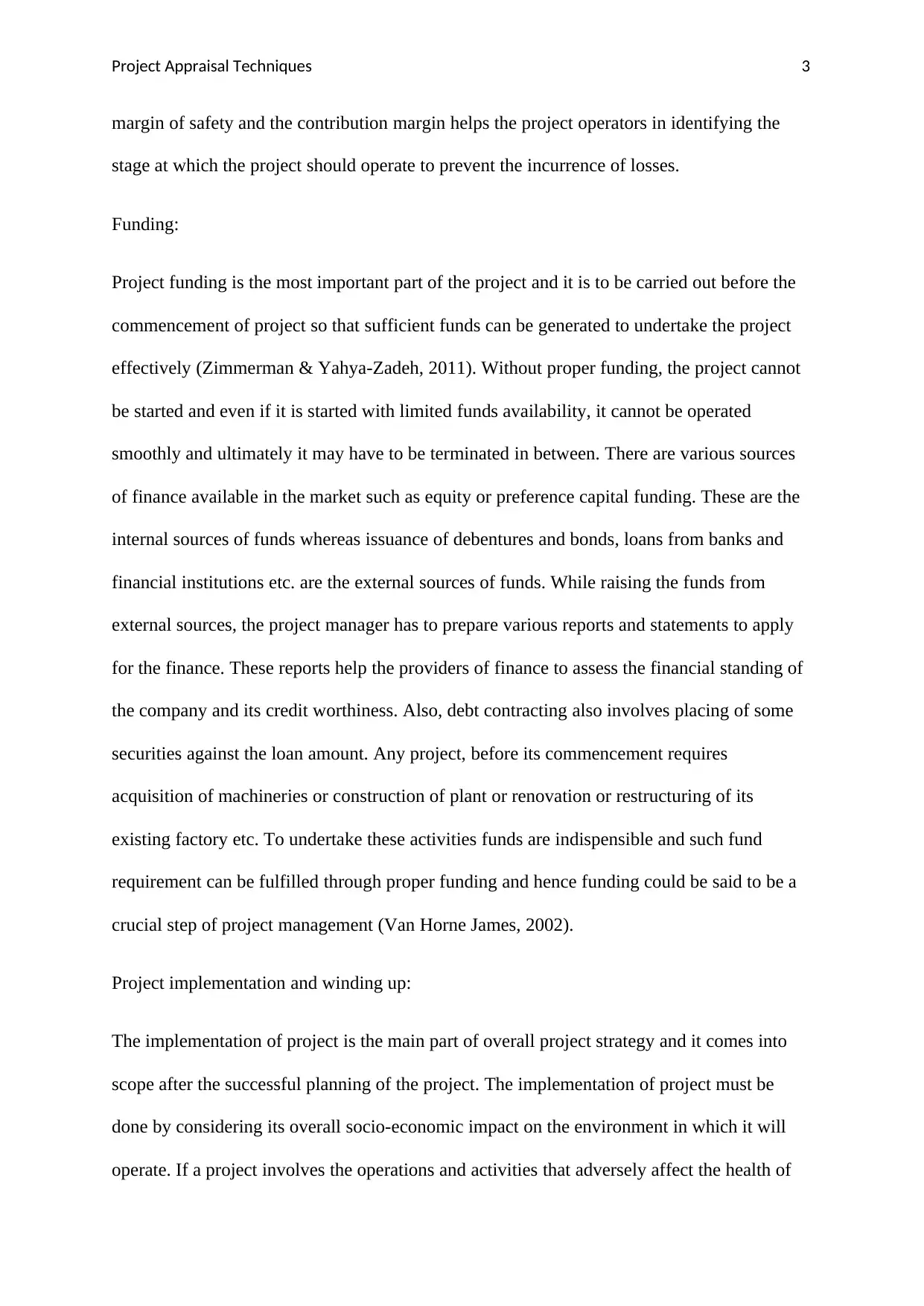
Project Appraisal Techniques 3
margin of safety and the contribution margin helps the project operators in identifying the
stage at which the project should operate to prevent the incurrence of losses.
Funding:
Project funding is the most important part of the project and it is to be carried out before the
commencement of project so that sufficient funds can be generated to undertake the project
effectively (Zimmerman & Yahya-Zadeh, 2011). Without proper funding, the project cannot
be started and even if it is started with limited funds availability, it cannot be operated
smoothly and ultimately it may have to be terminated in between. There are various sources
of finance available in the market such as equity or preference capital funding. These are the
internal sources of funds whereas issuance of debentures and bonds, loans from banks and
financial institutions etc. are the external sources of funds. While raising the funds from
external sources, the project manager has to prepare various reports and statements to apply
for the finance. These reports help the providers of finance to assess the financial standing of
the company and its credit worthiness. Also, debt contracting also involves placing of some
securities against the loan amount. Any project, before its commencement requires
acquisition of machineries or construction of plant or renovation or restructuring of its
existing factory etc. To undertake these activities funds are indispensible and such fund
requirement can be fulfilled through proper funding and hence funding could be said to be a
crucial step of project management (Van Horne James, 2002).
Project implementation and winding up:
The implementation of project is the main part of overall project strategy and it comes into
scope after the successful planning of the project. The implementation of project must be
done by considering its overall socio-economic impact on the environment in which it will
operate. If a project involves the operations and activities that adversely affect the health of
margin of safety and the contribution margin helps the project operators in identifying the
stage at which the project should operate to prevent the incurrence of losses.
Funding:
Project funding is the most important part of the project and it is to be carried out before the
commencement of project so that sufficient funds can be generated to undertake the project
effectively (Zimmerman & Yahya-Zadeh, 2011). Without proper funding, the project cannot
be started and even if it is started with limited funds availability, it cannot be operated
smoothly and ultimately it may have to be terminated in between. There are various sources
of finance available in the market such as equity or preference capital funding. These are the
internal sources of funds whereas issuance of debentures and bonds, loans from banks and
financial institutions etc. are the external sources of funds. While raising the funds from
external sources, the project manager has to prepare various reports and statements to apply
for the finance. These reports help the providers of finance to assess the financial standing of
the company and its credit worthiness. Also, debt contracting also involves placing of some
securities against the loan amount. Any project, before its commencement requires
acquisition of machineries or construction of plant or renovation or restructuring of its
existing factory etc. To undertake these activities funds are indispensible and such fund
requirement can be fulfilled through proper funding and hence funding could be said to be a
crucial step of project management (Van Horne James, 2002).
Project implementation and winding up:
The implementation of project is the main part of overall project strategy and it comes into
scope after the successful planning of the project. The implementation of project must be
done by considering its overall socio-economic impact on the environment in which it will
operate. If a project involves the operations and activities that adversely affect the health of
Paraphrase This Document
Need a fresh take? Get an instant paraphrase of this document with our AI Paraphraser
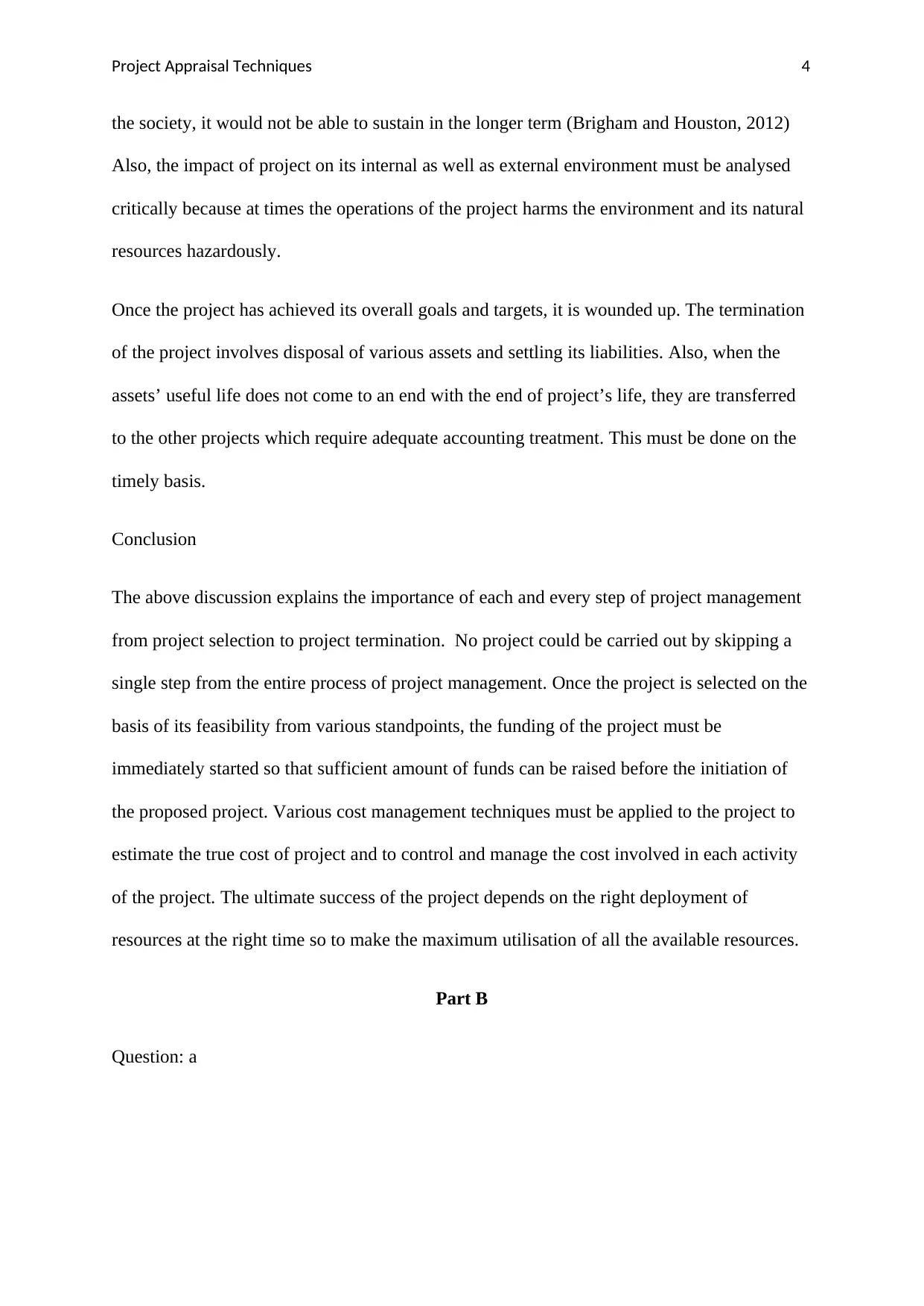
Project Appraisal Techniques 4
the society, it would not be able to sustain in the longer term (Brigham and Houston, 2012)
Also, the impact of project on its internal as well as external environment must be analysed
critically because at times the operations of the project harms the environment and its natural
resources hazardously.
Once the project has achieved its overall goals and targets, it is wounded up. The termination
of the project involves disposal of various assets and settling its liabilities. Also, when the
assets’ useful life does not come to an end with the end of project’s life, they are transferred
to the other projects which require adequate accounting treatment. This must be done on the
timely basis.
Conclusion
The above discussion explains the importance of each and every step of project management
from project selection to project termination. No project could be carried out by skipping a
single step from the entire process of project management. Once the project is selected on the
basis of its feasibility from various standpoints, the funding of the project must be
immediately started so that sufficient amount of funds can be raised before the initiation of
the proposed project. Various cost management techniques must be applied to the project to
estimate the true cost of project and to control and manage the cost involved in each activity
of the project. The ultimate success of the project depends on the right deployment of
resources at the right time so to make the maximum utilisation of all the available resources.
Part B
Question: a
the society, it would not be able to sustain in the longer term (Brigham and Houston, 2012)
Also, the impact of project on its internal as well as external environment must be analysed
critically because at times the operations of the project harms the environment and its natural
resources hazardously.
Once the project has achieved its overall goals and targets, it is wounded up. The termination
of the project involves disposal of various assets and settling its liabilities. Also, when the
assets’ useful life does not come to an end with the end of project’s life, they are transferred
to the other projects which require adequate accounting treatment. This must be done on the
timely basis.
Conclusion
The above discussion explains the importance of each and every step of project management
from project selection to project termination. No project could be carried out by skipping a
single step from the entire process of project management. Once the project is selected on the
basis of its feasibility from various standpoints, the funding of the project must be
immediately started so that sufficient amount of funds can be raised before the initiation of
the proposed project. Various cost management techniques must be applied to the project to
estimate the true cost of project and to control and manage the cost involved in each activity
of the project. The ultimate success of the project depends on the right deployment of
resources at the right time so to make the maximum utilisation of all the available resources.
Part B
Question: a
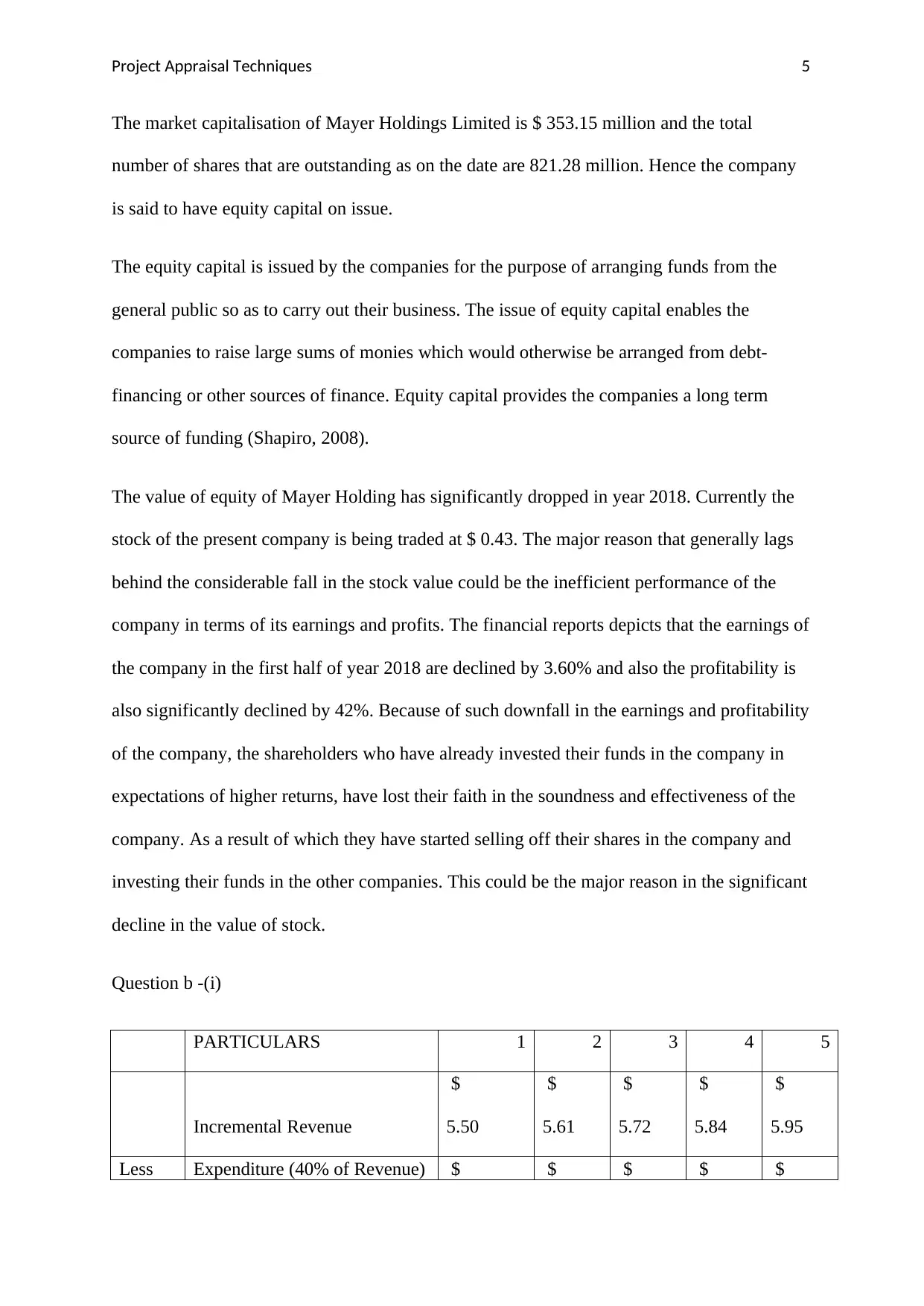
Project Appraisal Techniques 5
The market capitalisation of Mayer Holdings Limited is $ 353.15 million and the total
number of shares that are outstanding as on the date are 821.28 million. Hence the company
is said to have equity capital on issue.
The equity capital is issued by the companies for the purpose of arranging funds from the
general public so as to carry out their business. The issue of equity capital enables the
companies to raise large sums of monies which would otherwise be arranged from debt-
financing or other sources of finance. Equity capital provides the companies a long term
source of funding (Shapiro, 2008).
The value of equity of Mayer Holding has significantly dropped in year 2018. Currently the
stock of the present company is being traded at $ 0.43. The major reason that generally lags
behind the considerable fall in the stock value could be the inefficient performance of the
company in terms of its earnings and profits. The financial reports depicts that the earnings of
the company in the first half of year 2018 are declined by 3.60% and also the profitability is
also significantly declined by 42%. Because of such downfall in the earnings and profitability
of the company, the shareholders who have already invested their funds in the company in
expectations of higher returns, have lost their faith in the soundness and effectiveness of the
company. As a result of which they have started selling off their shares in the company and
investing their funds in the other companies. This could be the major reason in the significant
decline in the value of stock.
Question b -(i)
PARTICULARS 1 2 3 4 5
Incremental Revenue
$
5.50
$
5.61
$
5.72
$
5.84
$
5.95
Less Expenditure (40% of Revenue) $ $ $ $ $
The market capitalisation of Mayer Holdings Limited is $ 353.15 million and the total
number of shares that are outstanding as on the date are 821.28 million. Hence the company
is said to have equity capital on issue.
The equity capital is issued by the companies for the purpose of arranging funds from the
general public so as to carry out their business. The issue of equity capital enables the
companies to raise large sums of monies which would otherwise be arranged from debt-
financing or other sources of finance. Equity capital provides the companies a long term
source of funding (Shapiro, 2008).
The value of equity of Mayer Holding has significantly dropped in year 2018. Currently the
stock of the present company is being traded at $ 0.43. The major reason that generally lags
behind the considerable fall in the stock value could be the inefficient performance of the
company in terms of its earnings and profits. The financial reports depicts that the earnings of
the company in the first half of year 2018 are declined by 3.60% and also the profitability is
also significantly declined by 42%. Because of such downfall in the earnings and profitability
of the company, the shareholders who have already invested their funds in the company in
expectations of higher returns, have lost their faith in the soundness and effectiveness of the
company. As a result of which they have started selling off their shares in the company and
investing their funds in the other companies. This could be the major reason in the significant
decline in the value of stock.
Question b -(i)
PARTICULARS 1 2 3 4 5
Incremental Revenue
$
5.50
$
5.61
$
5.72
$
5.84
$
5.95
Less Expenditure (40% of Revenue) $ $ $ $ $
⊘ This is a preview!⊘
Do you want full access?
Subscribe today to unlock all pages.

Trusted by 1+ million students worldwide
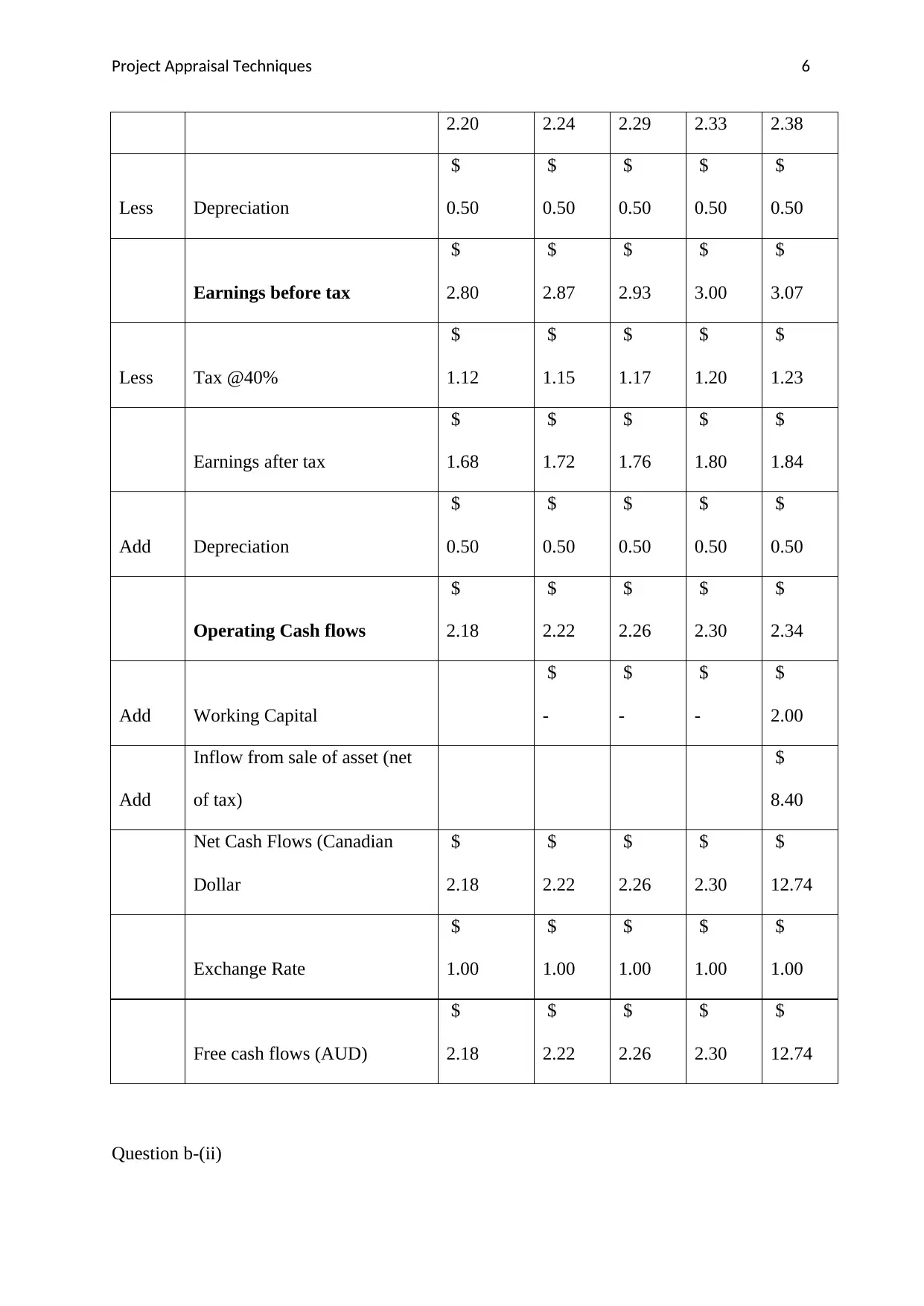
Project Appraisal Techniques 6
2.20 2.24 2.29 2.33 2.38
Less Depreciation
$
0.50
$
0.50
$
0.50
$
0.50
$
0.50
Earnings before tax
$
2.80
$
2.87
$
2.93
$
3.00
$
3.07
Less Tax @40%
$
1.12
$
1.15
$
1.17
$
1.20
$
1.23
Earnings after tax
$
1.68
$
1.72
$
1.76
$
1.80
$
1.84
Add Depreciation
$
0.50
$
0.50
$
0.50
$
0.50
$
0.50
Operating Cash flows
$
2.18
$
2.22
$
2.26
$
2.30
$
2.34
Add Working Capital
$
-
$
-
$
-
$
2.00
Add
Inflow from sale of asset (net
of tax)
$
8.40
Net Cash Flows (Canadian
Dollar
$
2.18
$
2.22
$
2.26
$
2.30
$
12.74
Exchange Rate
$
1.00
$
1.00
$
1.00
$
1.00
$
1.00
Free cash flows (AUD)
$
2.18
$
2.22
$
2.26
$
2.30
$
12.74
Question b-(ii)
2.20 2.24 2.29 2.33 2.38
Less Depreciation
$
0.50
$
0.50
$
0.50
$
0.50
$
0.50
Earnings before tax
$
2.80
$
2.87
$
2.93
$
3.00
$
3.07
Less Tax @40%
$
1.12
$
1.15
$
1.17
$
1.20
$
1.23
Earnings after tax
$
1.68
$
1.72
$
1.76
$
1.80
$
1.84
Add Depreciation
$
0.50
$
0.50
$
0.50
$
0.50
$
0.50
Operating Cash flows
$
2.18
$
2.22
$
2.26
$
2.30
$
2.34
Add Working Capital
$
-
$
-
$
-
$
2.00
Add
Inflow from sale of asset (net
of tax)
$
8.40
Net Cash Flows (Canadian
Dollar
$
2.18
$
2.22
$
2.26
$
2.30
$
12.74
Exchange Rate
$
1.00
$
1.00
$
1.00
$
1.00
$
1.00
Free cash flows (AUD)
$
2.18
$
2.22
$
2.26
$
2.30
$
12.74
Question b-(ii)
Paraphrase This Document
Need a fresh take? Get an instant paraphrase of this document with our AI Paraphraser
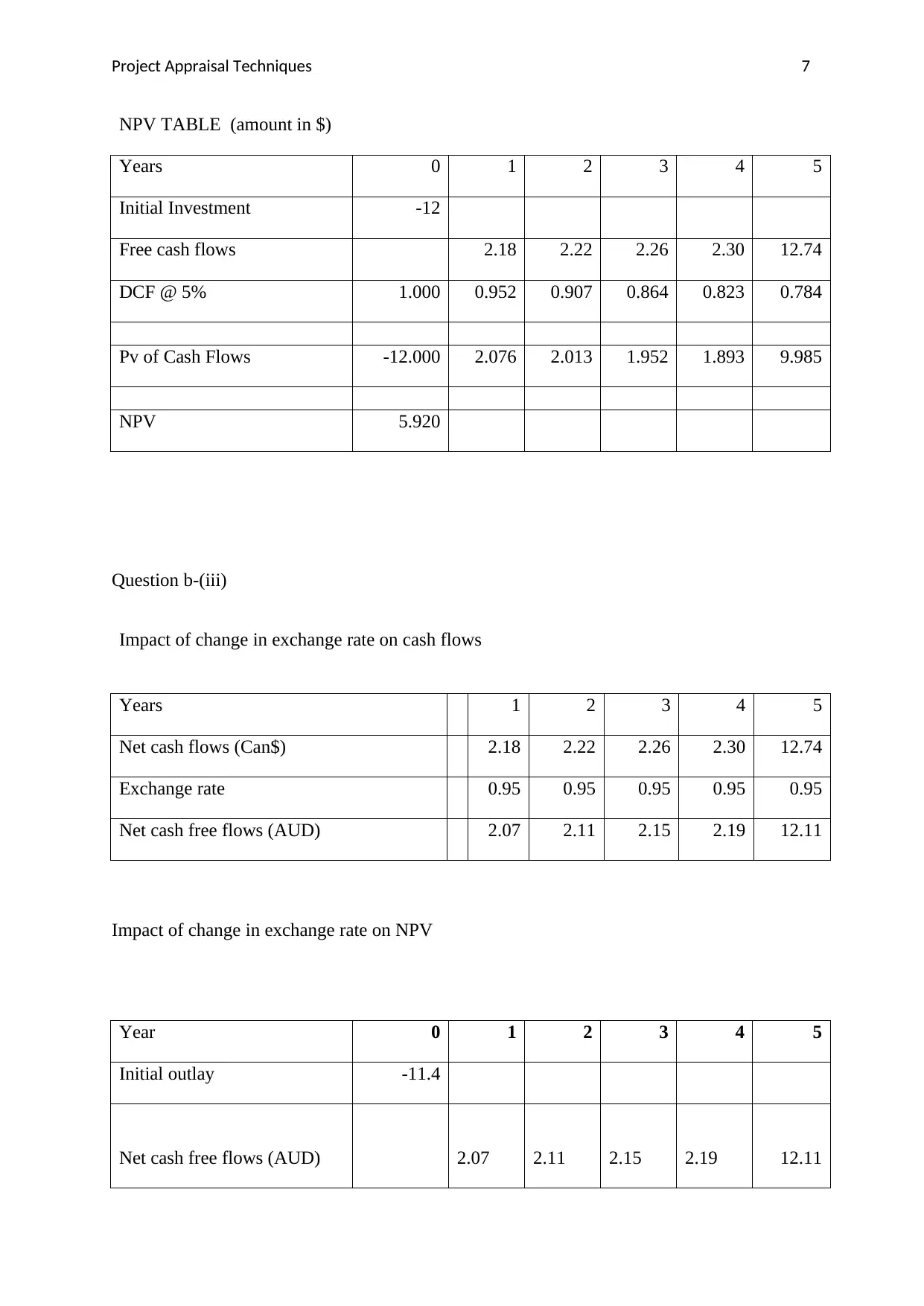
Project Appraisal Techniques 7
NPV TABLE (amount in $)
Years 0 1 2 3 4 5
Initial Investment -12
Free cash flows 2.18 2.22 2.26 2.30 12.74
DCF @ 5% 1.000 0.952 0.907 0.864 0.823 0.784
Pv of Cash Flows -12.000 2.076 2.013 1.952 1.893 9.985
NPV 5.920
Question b-(iii)
Impact of change in exchange rate on cash flows
Years 1 2 3 4 5
Net cash flows (Can$) 2.18 2.22 2.26 2.30 12.74
Exchange rate 0.95 0.95 0.95 0.95 0.95
Net cash free flows (AUD) 2.07 2.11 2.15 2.19 12.11
Impact of change in exchange rate on NPV
Year 0 1 2 3 4 5
Initial outlay -11.4
Net cash free flows (AUD) 2.07 2.11 2.15 2.19 12.11
NPV TABLE (amount in $)
Years 0 1 2 3 4 5
Initial Investment -12
Free cash flows 2.18 2.22 2.26 2.30 12.74
DCF @ 5% 1.000 0.952 0.907 0.864 0.823 0.784
Pv of Cash Flows -12.000 2.076 2.013 1.952 1.893 9.985
NPV 5.920
Question b-(iii)
Impact of change in exchange rate on cash flows
Years 1 2 3 4 5
Net cash flows (Can$) 2.18 2.22 2.26 2.30 12.74
Exchange rate 0.95 0.95 0.95 0.95 0.95
Net cash free flows (AUD) 2.07 2.11 2.15 2.19 12.11
Impact of change in exchange rate on NPV
Year 0 1 2 3 4 5
Initial outlay -11.4
Net cash free flows (AUD) 2.07 2.11 2.15 2.19 12.11
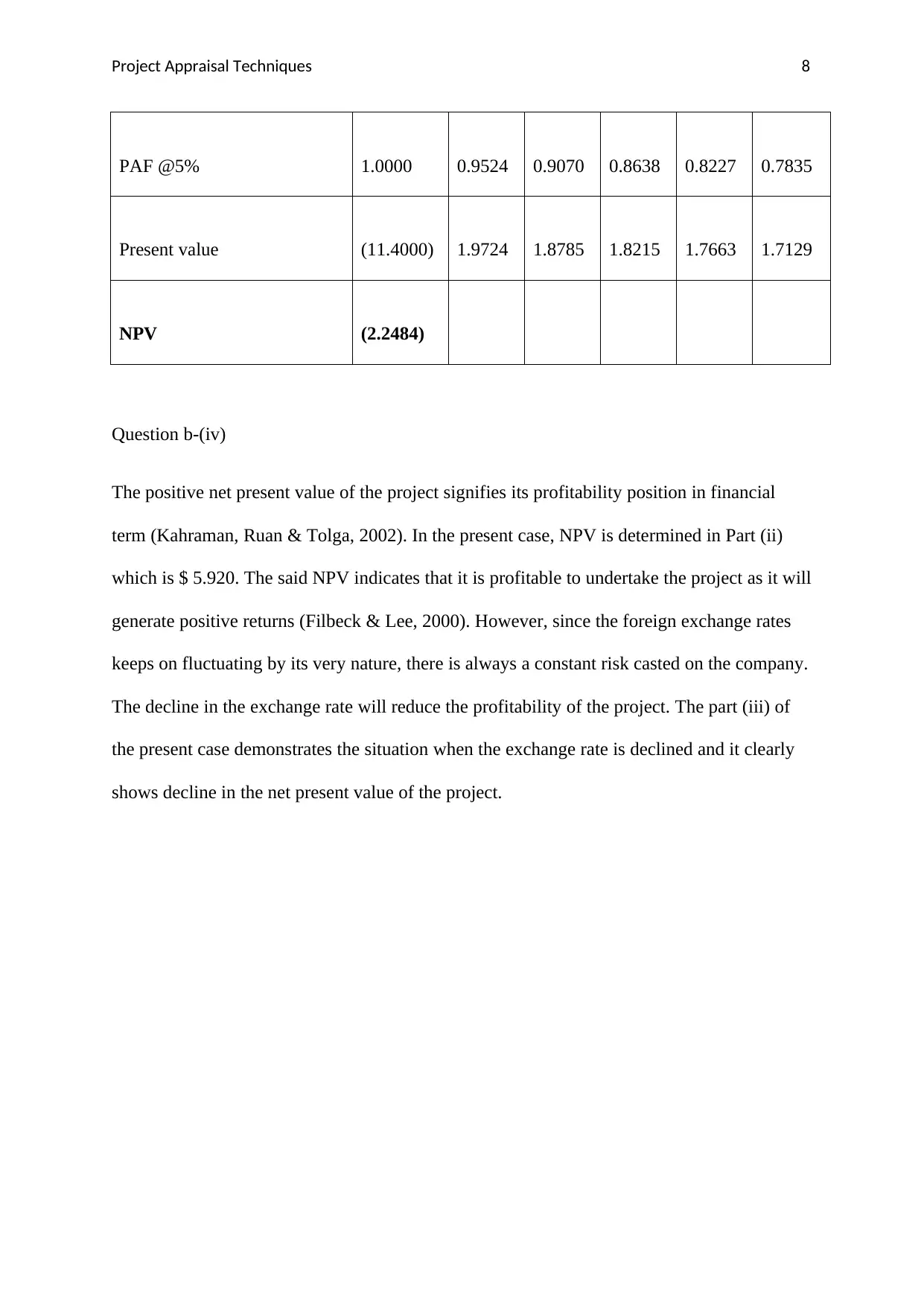
Project Appraisal Techniques 8
PAF @5% 1.0000 0.9524 0.9070 0.8638 0.8227 0.7835
Present value (11.4000) 1.9724 1.8785 1.8215 1.7663 1.7129
NPV (2.2484)
Question b-(iv)
The positive net present value of the project signifies its profitability position in financial
term (Kahraman, Ruan & Tolga, 2002). In the present case, NPV is determined in Part (ii)
which is $ 5.920. The said NPV indicates that it is profitable to undertake the project as it will
generate positive returns (Filbeck & Lee, 2000). However, since the foreign exchange rates
keeps on fluctuating by its very nature, there is always a constant risk casted on the company.
The decline in the exchange rate will reduce the profitability of the project. The part (iii) of
the present case demonstrates the situation when the exchange rate is declined and it clearly
shows decline in the net present value of the project.
PAF @5% 1.0000 0.9524 0.9070 0.8638 0.8227 0.7835
Present value (11.4000) 1.9724 1.8785 1.8215 1.7663 1.7129
NPV (2.2484)
Question b-(iv)
The positive net present value of the project signifies its profitability position in financial
term (Kahraman, Ruan & Tolga, 2002). In the present case, NPV is determined in Part (ii)
which is $ 5.920. The said NPV indicates that it is profitable to undertake the project as it will
generate positive returns (Filbeck & Lee, 2000). However, since the foreign exchange rates
keeps on fluctuating by its very nature, there is always a constant risk casted on the company.
The decline in the exchange rate will reduce the profitability of the project. The part (iii) of
the present case demonstrates the situation when the exchange rate is declined and it clearly
shows decline in the net present value of the project.
⊘ This is a preview!⊘
Do you want full access?
Subscribe today to unlock all pages.

Trusted by 1+ million students worldwide

Project Appraisal Techniques 9
References
Brigham, E.F. and Houston, J.F., 2012. Fundamentals of financial management. Cengage
Learning.
DRURY, C.M., 2013. Management and cost accounting. Springer.
Filbeck, G. and Lee, S., 2000. Financial management techniques in family businesses. Family
Business Review, 13(3), pp.201-216.
Hansen, D., Mowen, M. and Guan, L., 2007. Cost management: accounting and control.
Cengage Learning.
Kahraman, C., Ruan, D. and Tolga, E., 2002. Capital budgeting techniques using discounted
fuzzy versus probabilistic cash flows. Information Sciences, 142(1-4), pp.57-76.
Shapiro, A.C., 2008. Multinational financial management. John Wiley & Sons.
Van Horne James, C., 2002. Financial Management & Policy, 12/E. Pearson Education India.
Zimmerman, J.L. and Yahya-Zadeh, M., 2011. Accounting for decision making and control.
Issues in Accounting Education, 26(1), pp.258-259.
References
Brigham, E.F. and Houston, J.F., 2012. Fundamentals of financial management. Cengage
Learning.
DRURY, C.M., 2013. Management and cost accounting. Springer.
Filbeck, G. and Lee, S., 2000. Financial management techniques in family businesses. Family
Business Review, 13(3), pp.201-216.
Hansen, D., Mowen, M. and Guan, L., 2007. Cost management: accounting and control.
Cengage Learning.
Kahraman, C., Ruan, D. and Tolga, E., 2002. Capital budgeting techniques using discounted
fuzzy versus probabilistic cash flows. Information Sciences, 142(1-4), pp.57-76.
Shapiro, A.C., 2008. Multinational financial management. John Wiley & Sons.
Van Horne James, C., 2002. Financial Management & Policy, 12/E. Pearson Education India.
Zimmerman, J.L. and Yahya-Zadeh, M., 2011. Accounting for decision making and control.
Issues in Accounting Education, 26(1), pp.258-259.
1 out of 10
Related Documents
Your All-in-One AI-Powered Toolkit for Academic Success.
+13062052269
info@desklib.com
Available 24*7 on WhatsApp / Email
![[object Object]](/_next/static/media/star-bottom.7253800d.svg)
Unlock your academic potential
Copyright © 2020–2025 A2Z Services. All Rights Reserved. Developed and managed by ZUCOL.




